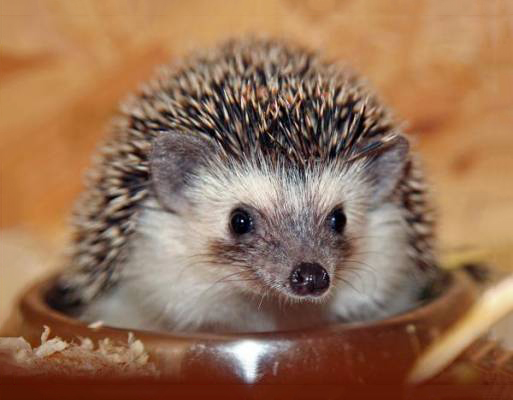
Somali hedgehog
Somali hedgehogs exitance is still very much questioned, even by scientists, due to the inability to do research within their natural habitat because of national safety issues in Somali and Eritrea. Scientists are even questioning if Somali hedgehogs are just different looking African pygmy hedgehogs.

Taxonomy
| Kingdom: | Animalia |
| Phylum: | Chordata |
| Class: | Mammalia |
| Order: | Eulipotyphla |
| Family: | Erinaceidae |
| Genus: | Atelerix |
| Species: | A. sclateri |
Natural habitat
The Somali hedgehog is a species found in East Africa. The species is very similar to the African pygmy hedgehog and has natural hybrids due to the large degree of overlap in their habitats. Very little is known about the species, mainly due to a lack of scientific research in Somalia due to the insecurity in the country.
Geography
The habitat of the Somali hedgehog is mainly in Somalia, although there are also sightings of the species in eastern Ethiopia. This mainly concerns the wide valleys along the rivers Shebelle and Jubba, both of which run from the mountain area in Ethiopia to the coast of Somalia and flow into the Indian Ocean.
Climate
Somalia has a warm desert climate and a steppe climate, with a year-round temperature between 20 and 32 degrees Celsius. The area has between 7 and 9 hours of sunlight per day year round. In the rainy season, rain falls on 8 days a month, rising to 5 mm per day. In the dry season there is a maximum of 1 day of rain per month with less than 0.5 mm on that day.
Flora & fauna
There is a wide variety of grasses and shrubs that store a lot of moisture, such as some Aloe species. There are not many tree species to be found, but consist of Acacia and Boswellia species.
Appearance
The Somali hedgehog is about 15 to 20 cm long and weighs between 250 and 500 grams. Seen from above, the hedgehog has a teardrop-shaped body and, viewed from the front, a heart-shaped head with the ears placed directly behind the eyes. The reversed mohawk, a bare stripe between the ears, is clearly visible with the dorsal muscles placed on either side. The Somali hedgehog has a small, light mask on the head, but a completely white belly, which makes it very similar to the African pygmy hedgehog. The difference is therefore only visible by looking at the hind legs. The Somali Hedgehog has five toes on the hind legs and five on the front legs, while the African pygmy hedgehog has four toes on the hind legs.
Hybrids in Somali hedgehogs
There is a great deal of uncertainty about the existence of the Somali hedgehog as a stand-alone species, partly due to the similarities with the African pygmy hedgehog, which also has a large overlapping habitat with the Somali Hedgehog. The only way to visually distinguish the species is by looking at the hind legs: the Somali Hedgehog has five toes while the African pygmy hedgehog has only four.
The species is currently classified as a stand-alone species, partly due to the lack of scientific research within the Somali hedgehog’s habitat, which is largely due to the insecure situation in Somalia. So not much can be done to classify the species differently within the Atelerix family. So, according to science, we continue to talk about the Atelerix sclateri, the Somali hedgehog.
However. there is great speculation as to whether the species should really continue to be called that, due to the overlapping habitats and the similarities between the African pygmy hedgehog and the Somali Hedgehog. According to some, it is a subspecies of the African pygmy hedgehog and the species would therefore be better described as ‘Ateleris albiventris sclateri’. The exact reason why a subspecies is thought of is the only difference between the animals: the number of toes on the hind legs.
According to others, it is actually a hybrid: a cross between the African pygmy hedgehog and the North African or South African Hedgehog. The main problem here is that both the North African and South African hedgehog species do not occur in Somalia and Ethiopia and a natural cross between these species is therefore not possible. And a hybrid created by humans is unlikely due to Somalia’s economic and social state. Then it would have to be an unnoticed introduction of the species into the habitat by, for example, truck traffic or tourism. A not very logical theory, but also not completely ruled out.
Still others claim a hybrid with an undiscovered species within the Atelerix family.
In any case, the exact situation is not entirely clear how this species came about and the situation surrounding the name of this species is uncertain. For the time being, the species will continue to be designated as a species in its own right, until it is possible to better research the species within its own habitat.
Somali hedgehogs in captivity
Due to the resemblance to African pygmy hedgehogs, there have been breeders in Europe around the year 2010 who claim to have owned a Somali Hedgehog and crossed it with African pygmy hedgehogs. However, due to a lack of scientific research, this cannot be proven and it would rather be African pygmy hedgehogs with a different appearance: the occasional fifth toe on the hind legs and darker colours. This could also involve imported African pygmy hedgehogs from African ‘farms’: large breeding companies that like to export to Europe and America in order to earn a lot of money. True wild-caught African pygmy hedgehogs are not easily found in captivity due to the ban on the export of wild animals, a legislation that is active in many countries within the habitat of the African pygmy hedgehog.
The so-called hybrid animals, however, quickly disappeared from the European domestic population: the animals often caused problems during pregnancy and childbirth and many of these died at a very young age or were found to be infertile. These are signs of hybrids between two species within the same family, but could also indicate weak genes within a population. The animals were in most cases closely related, which may also indicate excessive inbreeding with additional fertility problems.
